Individual BSc Project: Building a Nationwide ISP in Qatar (2018/2019)
VerifiedAdded on 2023/01/16
|102
|15734
|2
Project
AI Summary
This BSc project details the design and simulation of a nationwide Internet Service Provider (ISP) for Qatar, using OPNET modeler. The project begins with background information on ISP network design, routing, and addressing, considering different strategies for handling client prefixes. It covers various ISP connectivity types and technologies, including SONET, DSL, and PPP, along with applications like email, HTTP, FTP, and VoIP. The project focuses on network topology and application performance, building and simulating six network design scenarios based on two main topologies to determine the most efficient one. The analysis includes BGP and RIP routing protocols and performance metrics such as network convergence, email download/upload speeds, Ethernet delay, FTP transfer times, HTTP response times, TCP performance, and voice quality (jitter and packet delay). The project concludes with a discussion of limitations, recommendations, and potential future work. The project provides a practical approach to design and evaluate a nationwide ISP network.
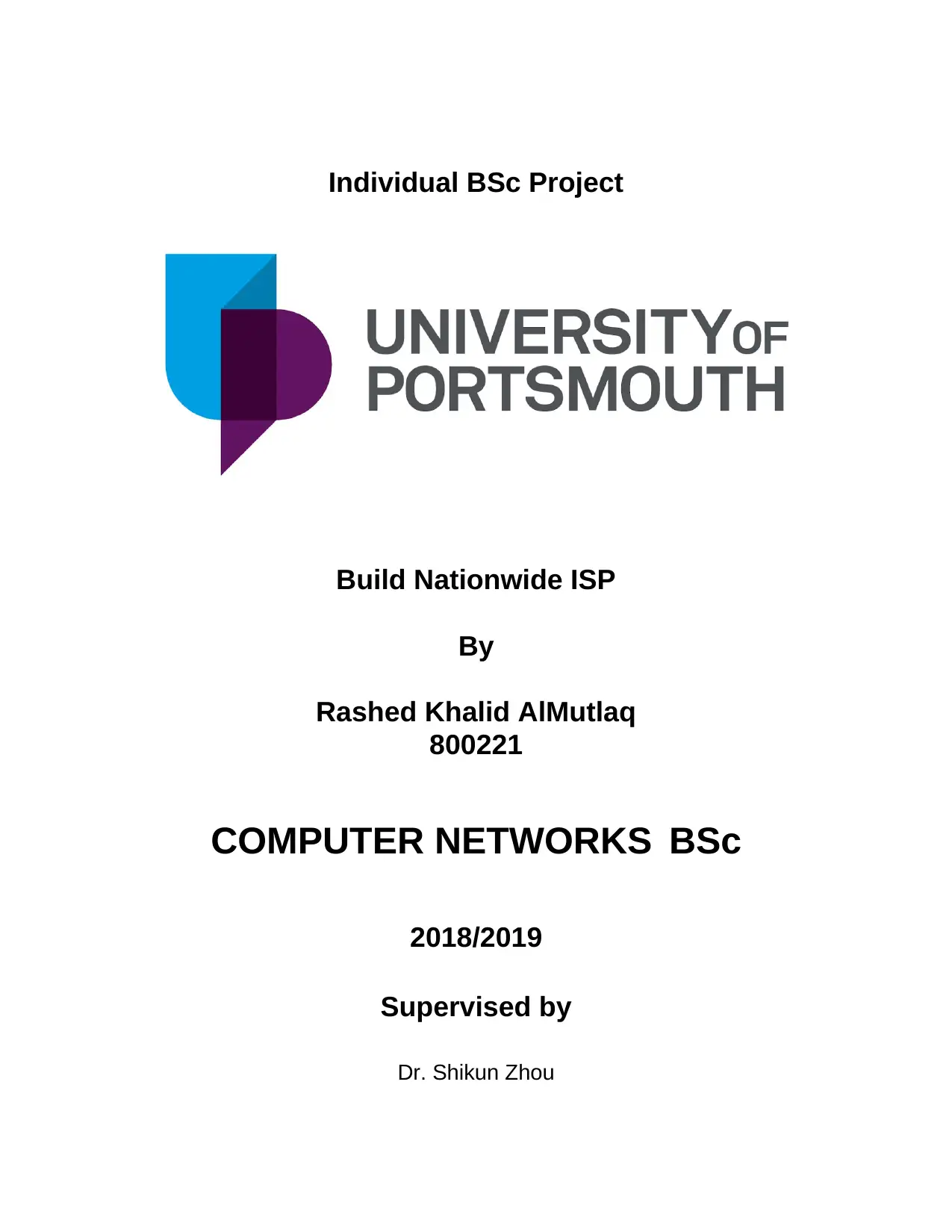
Individual BSc Project
Build Nationwide ISP
By
Rashed Khalid AlMutlaq
800221
COMPUTER NETWORKS BSc
2018/2019
Supervised by
Dr. Shikun Zhou
Build Nationwide ISP
By
Rashed Khalid AlMutlaq
800221
COMPUTER NETWORKS BSc
2018/2019
Supervised by
Dr. Shikun Zhou
Paraphrase This Document
Need a fresh take? Get an instant paraphrase of this document with our AI Paraphraser

ABSTRACT
ISP gives benefits that address the issues of clients. As indicated by that, ISP's system ought to be
assembled precisely to keep the forswearing of administration however much as could reasonably
be expected and give the administrations in a productive manner. This venture takes a principled
approaches to manage these difficulties. The task starts by exhibiting some foundation data about
ISP organize design utilizing OPNET. The essential arrangement of system configuration,
directing and tending to are clarified quickly. So as to manage prefixes data from client
associations, distinctive procedures are thought about. It additionally talks about the fundamental
sorts of ISP's availability. The innovations and the applications that are utilized in the task are
clarified succinctly. It additionally gives a short data about the Qatar as a nation, where the
undertaking will be connected. This undertaking additionally introduces how the required system
setups are connected for all intents and purposes on OPNET. Six situations of system designs are
made relying upon two primary topologies. The Six situations are assembled utilizing OPNET to
choose the most proficient one to plan and actualize the venture.
ISP gives benefits that address the issues of clients. As indicated by that, ISP's system ought to be
assembled precisely to keep the forswearing of administration however much as could reasonably
be expected and give the administrations in a productive manner. This venture takes a principled
approaches to manage these difficulties. The task starts by exhibiting some foundation data about
ISP organize design utilizing OPNET. The essential arrangement of system configuration,
directing and tending to are clarified quickly. So as to manage prefixes data from client
associations, distinctive procedures are thought about. It additionally talks about the fundamental
sorts of ISP's availability. The innovations and the applications that are utilized in the task are
clarified succinctly. It additionally gives a short data about the Qatar as a nation, where the
undertaking will be connected. This undertaking additionally introduces how the required system
setups are connected for all intents and purposes on OPNET. Six situations of system designs are
made relying upon two primary topologies. The Six situations are assembled utilizing OPNET to
choose the most proficient one to plan and actualize the venture.

ACKNOWLEDGEMENT
I might want to thank the accompanying individuals for their help and support. Thank to Dr.
Shikun Zhou my project supervisor, for his advices amid this undertaking. I might want to say
thanks to him for his accommodating direction, energetic provoking and for honorably giving
me his significant time. I give a modest gratitude to all the staff at School of Computing for the
incredible occupation they did in setting me up to get my [Degree category]. I likewise might
want to thank my dearest guardians, family and companions for their perpetual love and
backing.
I might want to thank the accompanying individuals for their help and support. Thank to Dr.
Shikun Zhou my project supervisor, for his advices amid this undertaking. I might want to say
thanks to him for his accommodating direction, energetic provoking and for honorably giving
me his significant time. I give a modest gratitude to all the staff at School of Computing for the
incredible occupation they did in setting me up to get my [Degree category]. I likewise might
want to thank my dearest guardians, family and companions for their perpetual love and
backing.
⊘ This is a preview!⊘
Do you want full access?
Subscribe today to unlock all pages.

Trusted by 1+ million students worldwide

DEDICATION
The dedication of this thesis goes to my beloved parents, brothers, sisters and friends who helped
me in one way or another to make this work a success. They have been so patient to see me
achieving this goal. I also thank Allah for being there for me, protecting me and giving me this
pressures gift of life.
The dedication of this thesis goes to my beloved parents, brothers, sisters and friends who helped
me in one way or another to make this work a success. They have been so patient to see me
achieving this goal. I also thank Allah for being there for me, protecting me and giving me this
pressures gift of life.
Paraphrase This Document
Need a fresh take? Get an instant paraphrase of this document with our AI Paraphraser

Table of Contents
ABSTRACT....................................................................................................................................2
ACKNOWLEDGEMENT.............................................................................................................3
DEDICATION................................................................................................................................4
CHAPTER ONE: INTRODUCTION...........................................................................................8
1.1 Background Information.........................................................................................................8
1.2 Problem Statement.................................................................................................................11
1.3 Objectives................................................................................................................................13
1.3.1 General Objectives...........................................................................................................13
1.3.2 Specific Objectives...........................................................................................................13
1.4 Project Outline........................................................................................................................14
CHAPTER TWO: LITERATURE REVIEW...........................................................................16
2.1 Introduction............................................................................................................................16
2.2 ISP Network Overview...........................................................................................................16
2.3 ISP Network Architecture.....................................................................................................17
1. Interior Gateway protocol layout.....................................................................................17
2. Network Layout.................................................................................................................18
Physical Layout.....................................................................................................................19
Logical Layout.......................................................................................................................20
ABSTRACT....................................................................................................................................2
ACKNOWLEDGEMENT.............................................................................................................3
DEDICATION................................................................................................................................4
CHAPTER ONE: INTRODUCTION...........................................................................................8
1.1 Background Information.........................................................................................................8
1.2 Problem Statement.................................................................................................................11
1.3 Objectives................................................................................................................................13
1.3.1 General Objectives...........................................................................................................13
1.3.2 Specific Objectives...........................................................................................................13
1.4 Project Outline........................................................................................................................14
CHAPTER TWO: LITERATURE REVIEW...........................................................................16
2.1 Introduction............................................................................................................................16
2.2 ISP Network Overview...........................................................................................................16
2.3 ISP Network Architecture.....................................................................................................17
1. Interior Gateway protocol layout.....................................................................................17
2. Network Layout.................................................................................................................18
Physical Layout.....................................................................................................................19
Logical Layout.......................................................................................................................20

3. Network addressing methodology....................................................................................20
Loopback Addressing...........................................................................................................20
Connection Addressing.........................................................................................................21
Client Addressing..................................................................................................................21
4. Customer Connectivity........................................................................................................21
Client BGP Peering...............................................................................................................22
Static Route Redistribution..................................................................................................22
5. Transit and Peering Overview.............................................................................................22
2.4 Synchronous Optical Network (SONET)........................................................................24
2.5 Digital Subscriber Line (DSL)...............................................................................................26
2.6 Point-to-point convention (PPP)...........................................................................................28
2.7 Qatar ISP Internet Application.............................................................................................29
2.7.1 Email Service....................................................................................................................29
2.7.2 Hypertext Transfer Protocol (HTTP)............................................................................30
2.7.3 File Transfer Protocol.....................................................................................................31
2.7.4 Voice over IP....................................................................................................................32
2.8 The Country of Qatar............................................................................................................34
2.8.1 Qatar Administrative Divisions and Internet...............................................................35
2.9 The OPNET.............................................................................................................................36
2.9.1 Creating Network Topology...........................................................................................36
Loopback Addressing...........................................................................................................20
Connection Addressing.........................................................................................................21
Client Addressing..................................................................................................................21
4. Customer Connectivity........................................................................................................21
Client BGP Peering...............................................................................................................22
Static Route Redistribution..................................................................................................22
5. Transit and Peering Overview.............................................................................................22
2.4 Synchronous Optical Network (SONET)........................................................................24
2.5 Digital Subscriber Line (DSL)...............................................................................................26
2.6 Point-to-point convention (PPP)...........................................................................................28
2.7 Qatar ISP Internet Application.............................................................................................29
2.7.1 Email Service....................................................................................................................29
2.7.2 Hypertext Transfer Protocol (HTTP)............................................................................30
2.7.3 File Transfer Protocol.....................................................................................................31
2.7.4 Voice over IP....................................................................................................................32
2.8 The Country of Qatar............................................................................................................34
2.8.1 Qatar Administrative Divisions and Internet...............................................................35
2.9 The OPNET.............................................................................................................................36
2.9.1 Creating Network Topology...........................................................................................36
⊘ This is a preview!⊘
Do you want full access?
Subscribe today to unlock all pages.

Trusted by 1+ million students worldwide
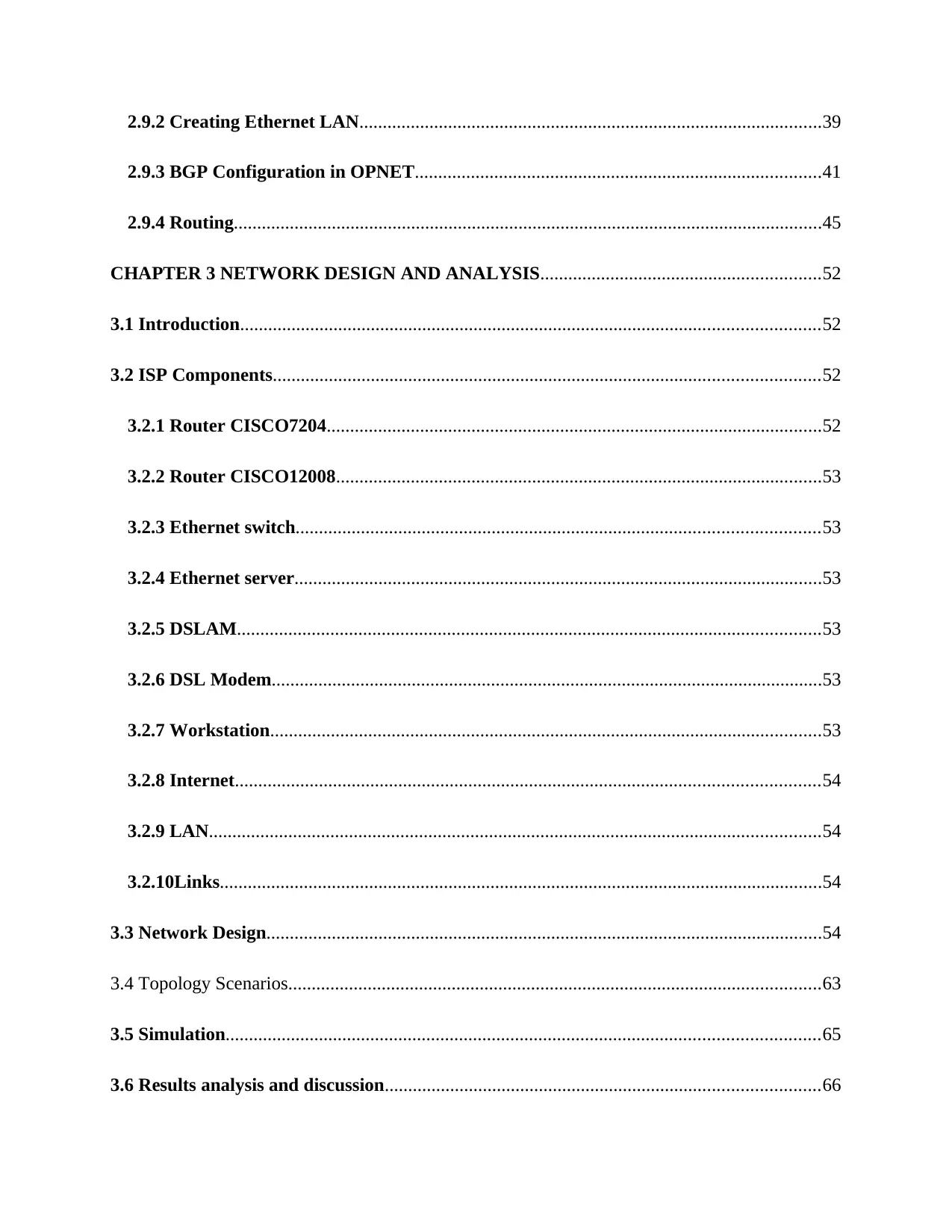
2.9.2 Creating Ethernet LAN...................................................................................................39
2.9.3 BGP Configuration in OPNET.......................................................................................41
2.9.4 Routing..............................................................................................................................45
CHAPTER 3 NETWORK DESIGN AND ANALYSIS............................................................52
3.1 Introduction............................................................................................................................52
3.2 ISP Components.....................................................................................................................52
3.2.1 Router CISCO7204..........................................................................................................52
3.2.2 Router CISCO12008........................................................................................................53
3.2.3 Ethernet switch................................................................................................................53
3.2.4 Ethernet server.................................................................................................................53
3.2.5 DSLAM.............................................................................................................................53
3.2.6 DSL Modem......................................................................................................................53
3.2.7 Workstation......................................................................................................................53
3.2.8 Internet.............................................................................................................................54
3.2.9 LAN...................................................................................................................................54
3.2.10Links.................................................................................................................................54
3.3 Network Design.......................................................................................................................54
3.4 Topology Scenarios..................................................................................................................63
3.5 Simulation...............................................................................................................................65
3.6 Results analysis and discussion.............................................................................................66
2.9.3 BGP Configuration in OPNET.......................................................................................41
2.9.4 Routing..............................................................................................................................45
CHAPTER 3 NETWORK DESIGN AND ANALYSIS............................................................52
3.1 Introduction............................................................................................................................52
3.2 ISP Components.....................................................................................................................52
3.2.1 Router CISCO7204..........................................................................................................52
3.2.2 Router CISCO12008........................................................................................................53
3.2.3 Ethernet switch................................................................................................................53
3.2.4 Ethernet server.................................................................................................................53
3.2.5 DSLAM.............................................................................................................................53
3.2.6 DSL Modem......................................................................................................................53
3.2.7 Workstation......................................................................................................................53
3.2.8 Internet.............................................................................................................................54
3.2.9 LAN...................................................................................................................................54
3.2.10Links.................................................................................................................................54
3.3 Network Design.......................................................................................................................54
3.4 Topology Scenarios..................................................................................................................63
3.5 Simulation...............................................................................................................................65
3.6 Results analysis and discussion.............................................................................................66
Paraphrase This Document
Need a fresh take? Get an instant paraphrase of this document with our AI Paraphraser
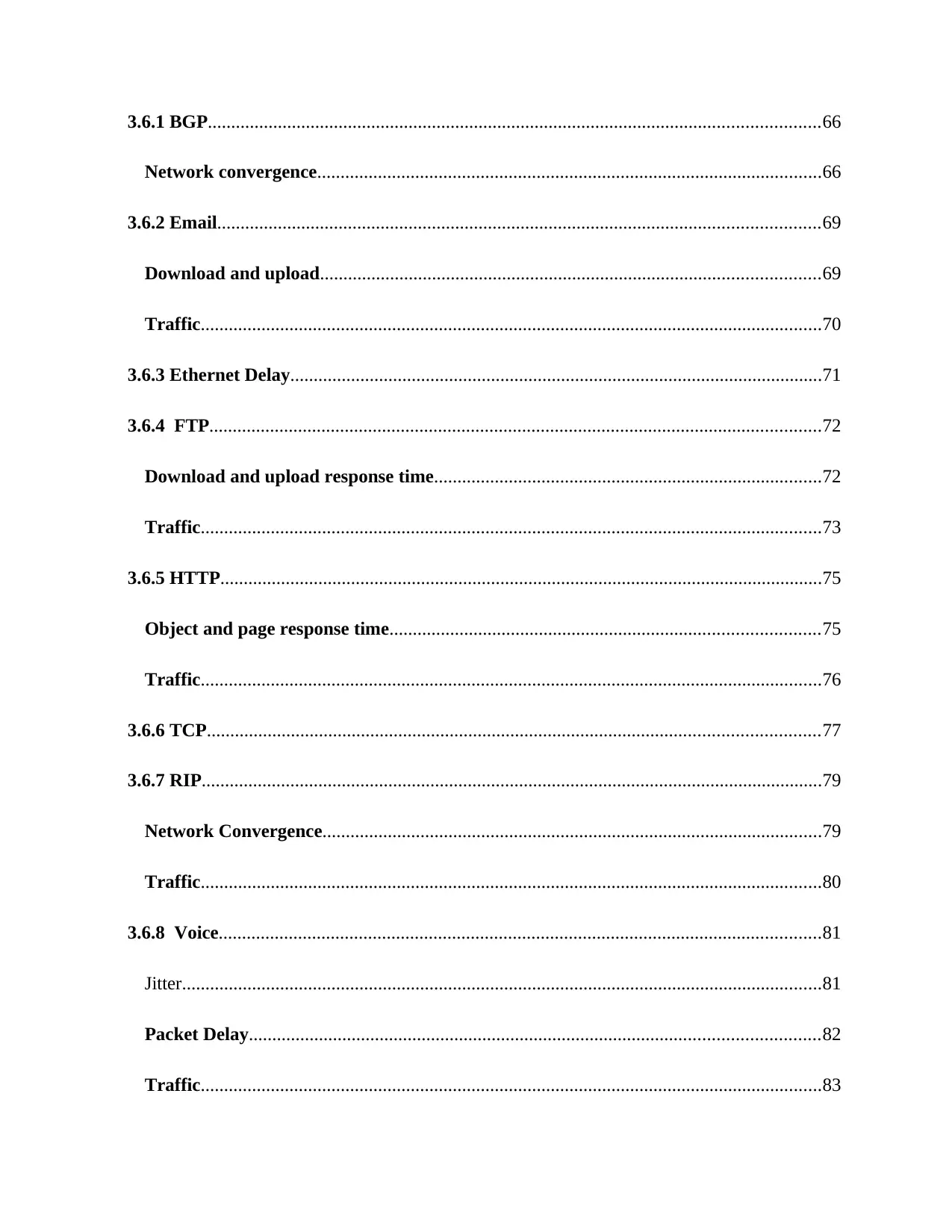
3.6.1 BGP...................................................................................................................................66
Network convergence............................................................................................................66
3.6.2 Email.................................................................................................................................69
Download and upload...........................................................................................................69
Traffic.....................................................................................................................................70
3.6.3 Ethernet Delay..................................................................................................................71
3.6.4 FTP...................................................................................................................................72
Download and upload response time...................................................................................72
Traffic.....................................................................................................................................73
3.6.5 HTTP.................................................................................................................................75
Object and page response time............................................................................................75
Traffic.....................................................................................................................................76
3.6.6 TCP...................................................................................................................................77
3.6.7 RIP.....................................................................................................................................79
Network Convergence...........................................................................................................79
Traffic.....................................................................................................................................80
3.6.8 Voice.................................................................................................................................81
Jitter.........................................................................................................................................81
Packet Delay..........................................................................................................................82
Traffic.....................................................................................................................................83
Network convergence............................................................................................................66
3.6.2 Email.................................................................................................................................69
Download and upload...........................................................................................................69
Traffic.....................................................................................................................................70
3.6.3 Ethernet Delay..................................................................................................................71
3.6.4 FTP...................................................................................................................................72
Download and upload response time...................................................................................72
Traffic.....................................................................................................................................73
3.6.5 HTTP.................................................................................................................................75
Object and page response time............................................................................................75
Traffic.....................................................................................................................................76
3.6.6 TCP...................................................................................................................................77
3.6.7 RIP.....................................................................................................................................79
Network Convergence...........................................................................................................79
Traffic.....................................................................................................................................80
3.6.8 Voice.................................................................................................................................81
Jitter.........................................................................................................................................81
Packet Delay..........................................................................................................................82
Traffic.....................................................................................................................................83
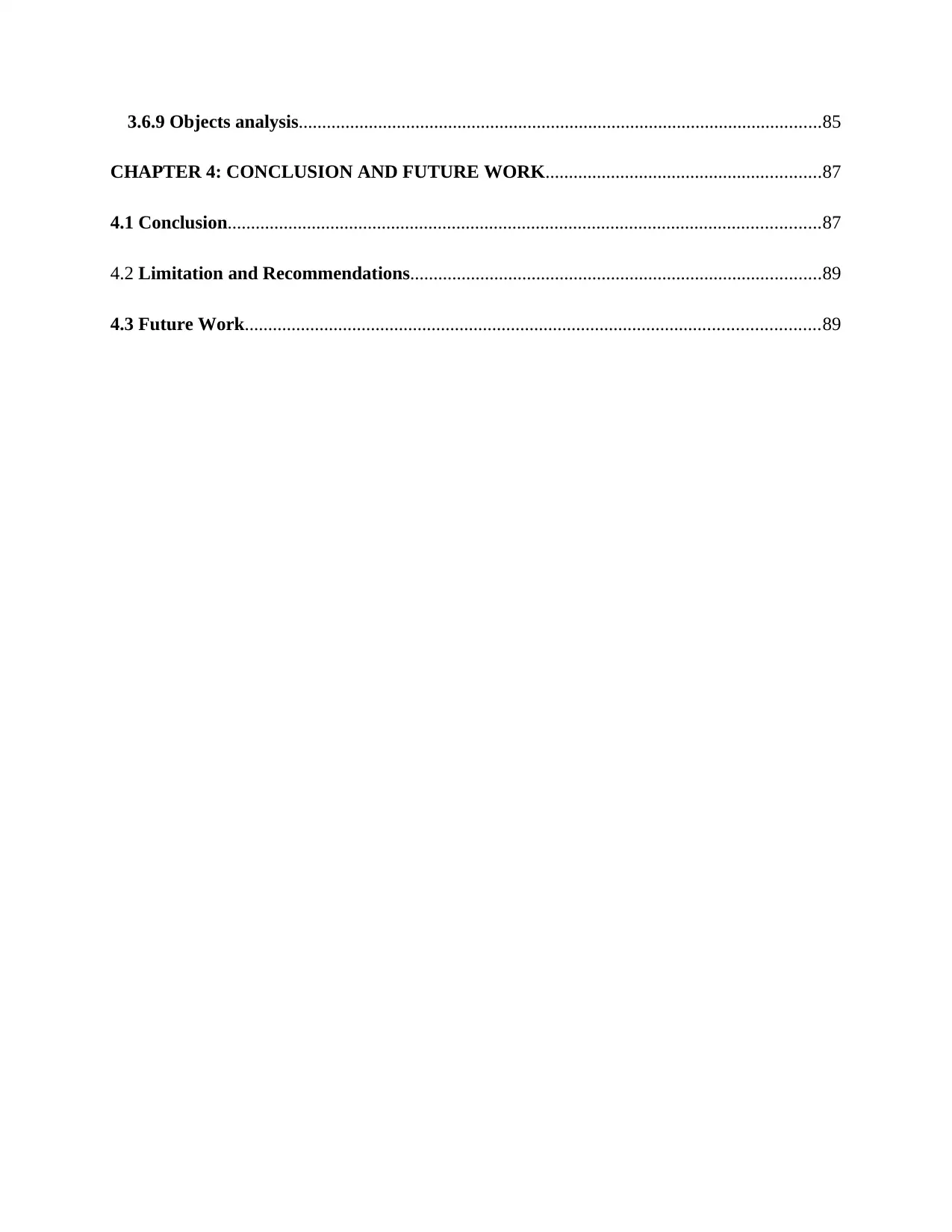
3.6.9 Objects analysis................................................................................................................85
CHAPTER 4: CONCLUSION AND FUTURE WORK...........................................................87
4.1 Conclusion...............................................................................................................................87
4.2 Limitation and Recommendations........................................................................................89
4.3 Future Work...........................................................................................................................89
CHAPTER 4: CONCLUSION AND FUTURE WORK...........................................................87
4.1 Conclusion...............................................................................................................................87
4.2 Limitation and Recommendations........................................................................................89
4.3 Future Work...........................................................................................................................89
⊘ This is a preview!⊘
Do you want full access?
Subscribe today to unlock all pages.

Trusted by 1+ million students worldwide
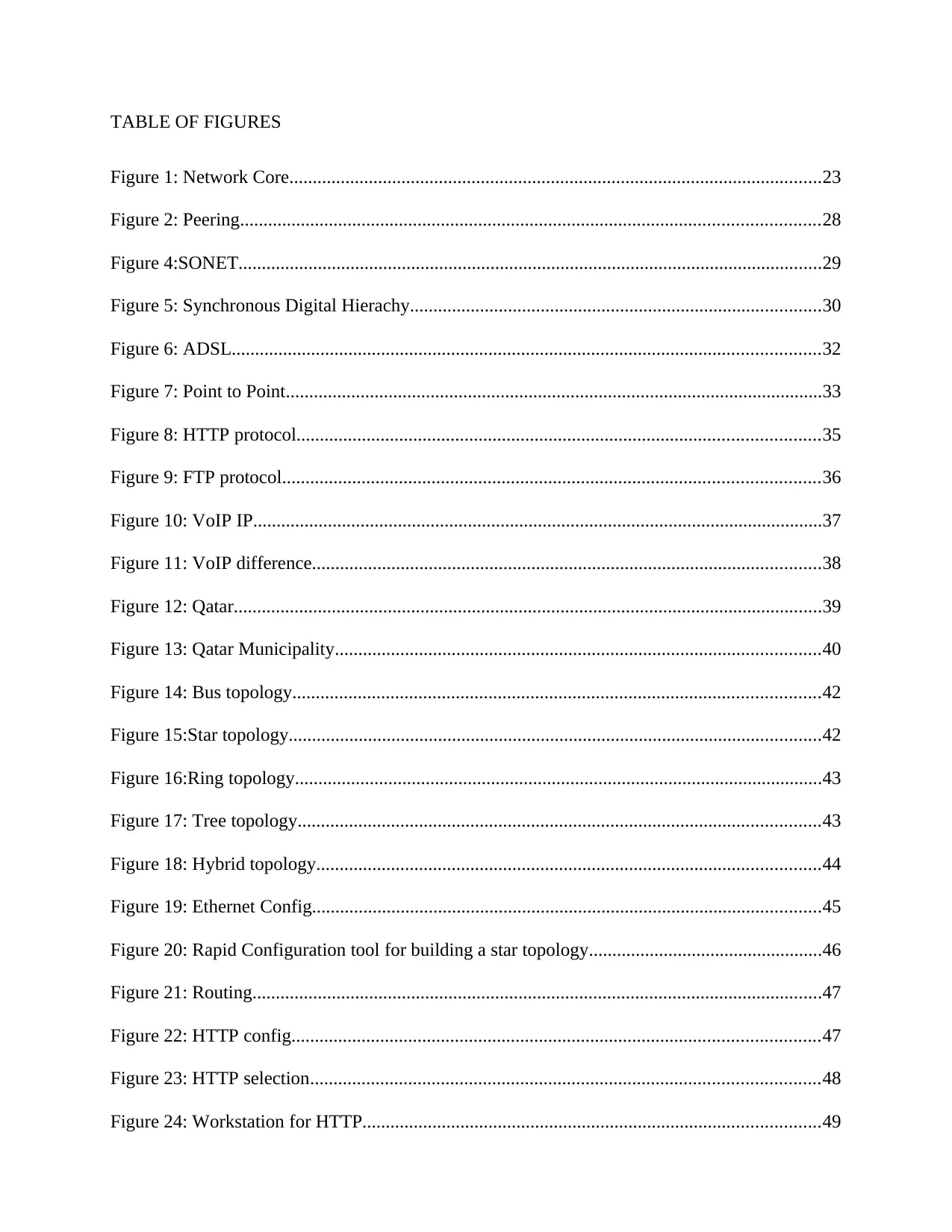
TABLE OF FIGURES
Figure 1: Network Core..................................................................................................................23
Figure 2: Peering............................................................................................................................28
Figure 4:SONET.............................................................................................................................29
Figure 5: Synchronous Digital Hierachy........................................................................................30
Figure 6: ADSL..............................................................................................................................32
Figure 7: Point to Point...................................................................................................................33
Figure 8: HTTP protocol................................................................................................................35
Figure 9: FTP protocol...................................................................................................................36
Figure 10: VoIP IP..........................................................................................................................37
Figure 11: VoIP difference.............................................................................................................38
Figure 12: Qatar..............................................................................................................................39
Figure 13: Qatar Municipality........................................................................................................40
Figure 14: Bus topology.................................................................................................................42
Figure 15:Star topology..................................................................................................................42
Figure 16:Ring topology.................................................................................................................43
Figure 17: Tree topology................................................................................................................43
Figure 18: Hybrid topology............................................................................................................44
Figure 19: Ethernet Config.............................................................................................................45
Figure 20: Rapid Configuration tool for building a star topology..................................................46
Figure 21: Routing..........................................................................................................................47
Figure 22: HTTP config.................................................................................................................47
Figure 23: HTTP selection.............................................................................................................48
Figure 24: Workstation for HTTP..................................................................................................49
Figure 1: Network Core..................................................................................................................23
Figure 2: Peering............................................................................................................................28
Figure 4:SONET.............................................................................................................................29
Figure 5: Synchronous Digital Hierachy........................................................................................30
Figure 6: ADSL..............................................................................................................................32
Figure 7: Point to Point...................................................................................................................33
Figure 8: HTTP protocol................................................................................................................35
Figure 9: FTP protocol...................................................................................................................36
Figure 10: VoIP IP..........................................................................................................................37
Figure 11: VoIP difference.............................................................................................................38
Figure 12: Qatar..............................................................................................................................39
Figure 13: Qatar Municipality........................................................................................................40
Figure 14: Bus topology.................................................................................................................42
Figure 15:Star topology..................................................................................................................42
Figure 16:Ring topology.................................................................................................................43
Figure 17: Tree topology................................................................................................................43
Figure 18: Hybrid topology............................................................................................................44
Figure 19: Ethernet Config.............................................................................................................45
Figure 20: Rapid Configuration tool for building a star topology..................................................46
Figure 21: Routing..........................................................................................................................47
Figure 22: HTTP config.................................................................................................................47
Figure 23: HTTP selection.............................................................................................................48
Figure 24: Workstation for HTTP..................................................................................................49
Paraphrase This Document
Need a fresh take? Get an instant paraphrase of this document with our AI Paraphraser

Figure 25: HTTP server..................................................................................................................49
Figure 26: HTTP server side..........................................................................................................50
Figure 27: Routing..........................................................................................................................50
Figure 28: BGP basic......................................................................................................................51
Figure 29: Running the BGP..........................................................................................................52
Figure 30: The router attributes......................................................................................................53
Figure 31: The R4 attributes...........................................................................................................54
Figure 32: Information for BGP and RIP.......................................................................................54
Figure 33: Exporting routing table.................................................................................................55
Figure 34: RIP Protocol..................................................................................................................56
Figure 35: RIP parameters..............................................................................................................56
Figure 36: OPNET Pallette.............................................................................................................60
Figure 37: OPNET on the map.......................................................................................................60
Figure 38: Subnet centres...............................................................................................................61
Figure 39: LAN connection to subnet............................................................................................62
Figure 40: LAN attributes..............................................................................................................62
Figure 41: DSLAM 2......................................................................................................................63
Figure 42: Connecting user to main routers...................................................................................63
Figure 43: Connection of core router.............................................................................................64
Figure 44: VoIP connection to router.............................................................................................65
Figure 45: Ethernet server..............................................................................................................65
Figure 46: FTP server connection..................................................................................................66
Figure 47: Core router configuration..............................................................................................67
Figure 48: Application connection.................................................................................................67
Figure 26: HTTP server side..........................................................................................................50
Figure 27: Routing..........................................................................................................................50
Figure 28: BGP basic......................................................................................................................51
Figure 29: Running the BGP..........................................................................................................52
Figure 30: The router attributes......................................................................................................53
Figure 31: The R4 attributes...........................................................................................................54
Figure 32: Information for BGP and RIP.......................................................................................54
Figure 33: Exporting routing table.................................................................................................55
Figure 34: RIP Protocol..................................................................................................................56
Figure 35: RIP parameters..............................................................................................................56
Figure 36: OPNET Pallette.............................................................................................................60
Figure 37: OPNET on the map.......................................................................................................60
Figure 38: Subnet centres...............................................................................................................61
Figure 39: LAN connection to subnet............................................................................................62
Figure 40: LAN attributes..............................................................................................................62
Figure 41: DSLAM 2......................................................................................................................63
Figure 42: Connecting user to main routers...................................................................................63
Figure 43: Connection of core router.............................................................................................64
Figure 44: VoIP connection to router.............................................................................................65
Figure 45: Ethernet server..............................................................................................................65
Figure 46: FTP server connection..................................................................................................66
Figure 47: Core router configuration..............................................................................................67
Figure 48: Application connection.................................................................................................67
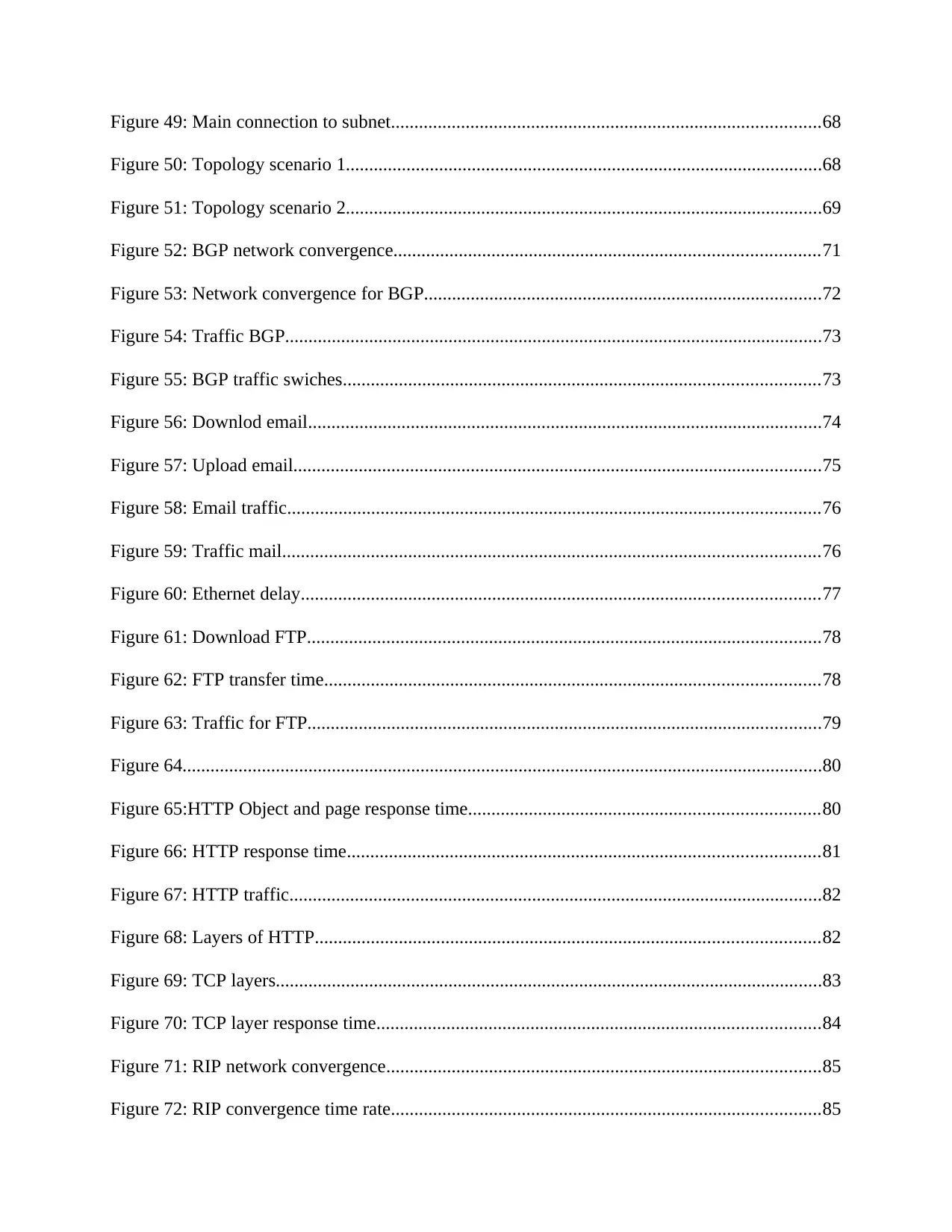
Figure 49: Main connection to subnet............................................................................................68
Figure 50: Topology scenario 1......................................................................................................68
Figure 51: Topology scenario 2......................................................................................................69
Figure 52: BGP network convergence...........................................................................................71
Figure 53: Network convergence for BGP.....................................................................................72
Figure 54: Traffic BGP...................................................................................................................73
Figure 55: BGP traffic swiches......................................................................................................73
Figure 56: Downlod email..............................................................................................................74
Figure 57: Upload email.................................................................................................................75
Figure 58: Email traffic..................................................................................................................76
Figure 59: Traffic mail...................................................................................................................76
Figure 60: Ethernet delay...............................................................................................................77
Figure 61: Download FTP..............................................................................................................78
Figure 62: FTP transfer time..........................................................................................................78
Figure 63: Traffic for FTP..............................................................................................................79
Figure 64.........................................................................................................................................80
Figure 65:HTTP Object and page response time...........................................................................80
Figure 66: HTTP response time.....................................................................................................81
Figure 67: HTTP traffic..................................................................................................................82
Figure 68: Layers of HTTP............................................................................................................82
Figure 69: TCP layers.....................................................................................................................83
Figure 70: TCP layer response time...............................................................................................84
Figure 71: RIP network convergence.............................................................................................85
Figure 72: RIP convergence time rate............................................................................................85
Figure 50: Topology scenario 1......................................................................................................68
Figure 51: Topology scenario 2......................................................................................................69
Figure 52: BGP network convergence...........................................................................................71
Figure 53: Network convergence for BGP.....................................................................................72
Figure 54: Traffic BGP...................................................................................................................73
Figure 55: BGP traffic swiches......................................................................................................73
Figure 56: Downlod email..............................................................................................................74
Figure 57: Upload email.................................................................................................................75
Figure 58: Email traffic..................................................................................................................76
Figure 59: Traffic mail...................................................................................................................76
Figure 60: Ethernet delay...............................................................................................................77
Figure 61: Download FTP..............................................................................................................78
Figure 62: FTP transfer time..........................................................................................................78
Figure 63: Traffic for FTP..............................................................................................................79
Figure 64.........................................................................................................................................80
Figure 65:HTTP Object and page response time...........................................................................80
Figure 66: HTTP response time.....................................................................................................81
Figure 67: HTTP traffic..................................................................................................................82
Figure 68: Layers of HTTP............................................................................................................82
Figure 69: TCP layers.....................................................................................................................83
Figure 70: TCP layer response time...............................................................................................84
Figure 71: RIP network convergence.............................................................................................85
Figure 72: RIP convergence time rate............................................................................................85
⊘ This is a preview!⊘
Do you want full access?
Subscribe today to unlock all pages.

Trusted by 1+ million students worldwide
1 out of 102
Your All-in-One AI-Powered Toolkit for Academic Success.
+13062052269
info@desklib.com
Available 24*7 on WhatsApp / Email
![[object Object]](/_next/static/media/star-bottom.7253800d.svg)
Unlock your academic potential
Copyright © 2020–2025 A2Z Services. All Rights Reserved. Developed and managed by ZUCOL.